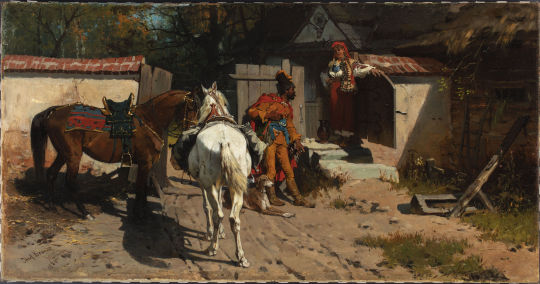#józef Brandt
Text

Józef Brandt (1841-1915), famous Polish artist, fascinated with the Ukrainian Cossacks and creating pictures of them throughout all his life:
Farewell (Pożegnanie), 1867, oil on canvas, 39 cm X 61.5 cm
From the collection of the Borys Voznytsky Lviv National Art Gallery (Львівська Національна Галерея Мистецтв імені Бориса Возницького)
Żal cię tu samą zostawiać — mówił Bohun — żal odjeżdżać, ale mus. Lżejby było, żeby ty się uśmiechnęła, żeby krzyżyk ze szczerego serca dała.
#polish art#traditional art#józef brandt#cossack art#cossack heroes#cossacks#ukrainian history#ukrainian heritage#bohun vibe#ogniem i mieczem#trylogia
101 notes
·
View notes
Text

Józef Brandt, Wesele kozackie (Cossack Wedding)
1893
#poland#polish culture#polish art#polish painters#polish paintings#european paintings#european art#józef Brandt#brandt#polska
63 notes
·
View notes
Text
Sukiennice Gallery of 19th-Century Polish Art Kraków
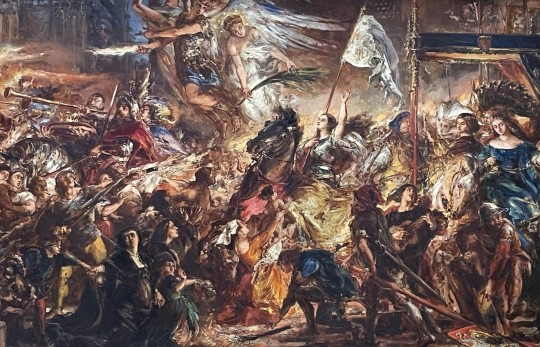
View On WordPress
#18th and 19th-Century Polish Paintings and Sculpture#Adam Chmielowski#Alexander Gierymski#Antoni Adam Piotrowski#Bacciarelli Room Sukiennice#Chełmoński Room Sukiennice#Cloth Hall#Henryk Rodakowski#Henryk Siemiradzki#Jacek Malczewski#Jan Matejko#Jan Piotr Norblin#Jan Stanisławski#Józef Brandt#Józef Pankiewicz#Józef Peszka Jan Bogumil Plersch#Josef Chełmoński#Kraków Market Square#Leon Wyczółkowski#Maksymilian Gierymski#Marcello Bacciarelli#Michałowski Room Sukiennice#National Museum Kraków#Piotr Michałowski#Pius Welonski#Siemiradzki Room Sukiennice#Stanislaw Maslowski#Sukiennice#Tadeusz Ajdukiewiz
0 notes
Text

Cossack on duty (portrayal of 16th–17th century), painting by Józef Brandt
41 notes
·
View notes
Text
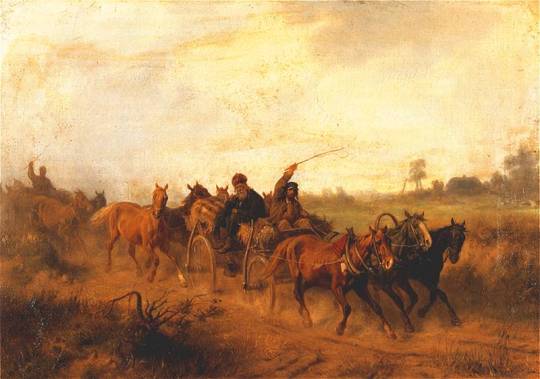
Jews on the way to the fair, by Józef Brandt
41 notes
·
View notes
Text
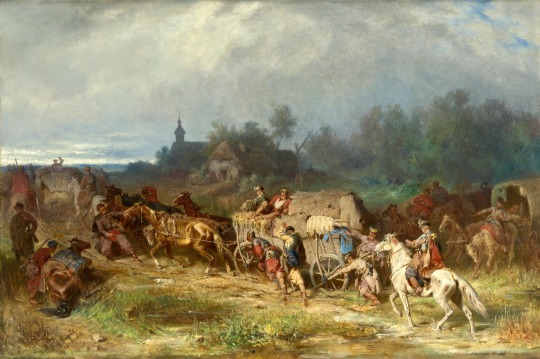
Józef von Brandt, Returning Home
"Patient Transport (Polish Camp)"
Oil on canvas
Dorotheum
2 notes
·
View notes
Text
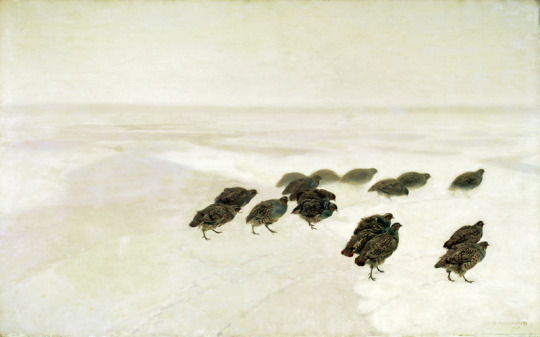
Józef Chełmoński, Partriges, 1891, oil on canvas, photo: courtesy of the National Museum, Warsaw.
約瑟夫·赫爾蒙斯基(Józef Chełmoński)《灰山鶉》"Kuropatwy/Partriges", 1891年. 華沙國家博物館
Józef Chełmoński (1849-1914),19世紀下半葉在德國受過教育的著名波蘭學術畫家最著名的作品之一,屬於其典型作品,因為展示了波蘭大自然。赫爾蒙斯基主要在馬佐夫捨地區的鄉村創造了其風景。”
Polish painter and illustrator active in Munich, Paris, and Warsaw, leading representative of realism. Born 1849 in Boczki near Łowicz, died 1914 in Kuklówka near Grodzisk Mazowiecki.
Between 1867-1871 Chełmoński studied at the Warsaw Drawing Class (School) and in the private studio of Wojciech Gerson. In 1872, he continued his studies at the Munich Academy of Fine Arts under H. Anschütz and A. Strähuber. He became familiar there with the milieu of the Polish 'Munich painters', notably Stanisław Witkiewicz, Józef Brandt, Maksymilian Gierymski and Adam Chmielowski; he was admitted as member of the Kunstverein, with which he exhibited.
In 1874 he went to Ukraine, from where he returned to Warsaw. He remained in close touch with Witkiewicz and Chmielowski, sharing with them an atelier rented at Hotel Europejski. In 1872 and 1874-1875 he makes several trips to Podole and Ukraine, the reminiscences of which will play an important role in the shaping of his artistic position.
5 notes
·
View notes
Text

Cossack on Duty, by Józef Brandt
'The Cossacks were the hunters and brigands, horsemen and stockraisers who roamed the "wild country" (dikoe pole) left by the breakup of the Golden Horde. This was indeterminate steppe territory surrounded by established states: Muscovy, Poland, the Ottoman Empire, the Crimean khanate, the Nogai Horde, and the north Caucasian tribal kingdoms. Cossacks had no state formation of their own, but lived in loose military fraternities, cultivating the skills of horsemanship crucial to survival on the plains. The name by which they were known is Turkic and means "free man." In its essentials they adopted the lifestyle of the nomads.
The first concentrations of Cossacks were in the lower reaches of two great rivers, the Don and the Dnieper. In the early stages many of them were Tatars, survivors perhaps of the Golden Horde or other nomadic hosts, but many too were Slavs, hunters, fisherman, and traders who had strayed from the borders of Poland or Muscovy, peasants or even landowners fleeing from justice or injustice in their homeland. In time the Slavic element became dominant and most Cossacks adopted the Orthodox faith.'
Russia and the Russians, by Geoffrey Hosking
0 notes
Photo
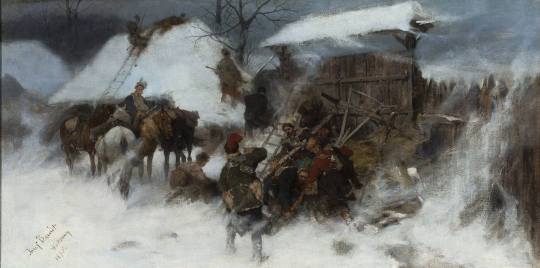
“Bar confederates“ (1875)
Józef Brandt (Polish;1841-1915)
oil on canvas
National Museum, Warsaw
#Józef Brandt#brandt#history#Polish history#art#artist#snow#polish art#polish artist#winter#poland#painting#painters#Polish painters
42 notes
·
View notes
Photo
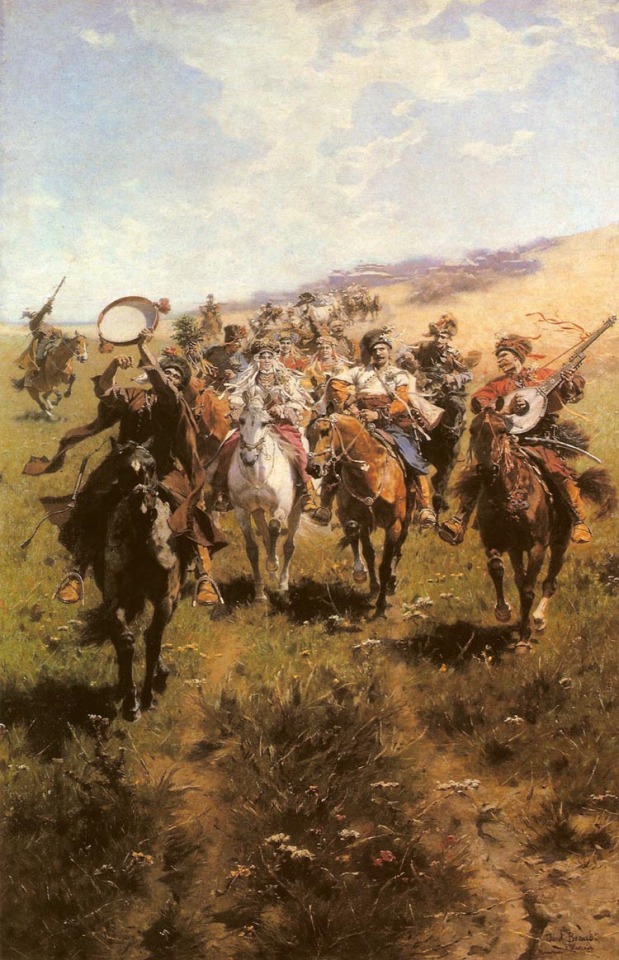
“Wesele kozackie” (”Cossack wedding”)
Józef Brandt
95 notes
·
View notes
Photo
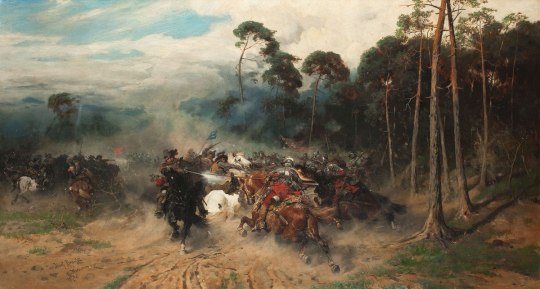
Potyczka ze Szwedami - Józef Brandt.
5 notes
·
View notes
Photo

“A Prize Thoroughbred” by Józef Brandt (Polish;1841-1915), oil on canvas, private collection
Sothebys
#Józef Brandt#brandt#art#artist#painter#poland#polish art#polish artist#Polish painters#Polish Painter
36 notes
·
View notes
Photo
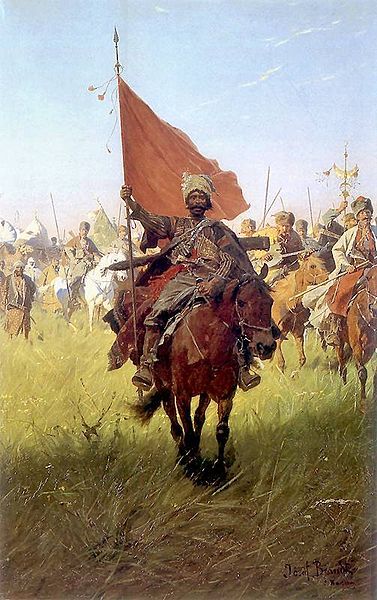
Triumphant Return of the Cossacks, Józef Brandt, 19th century, oil on canvas
The Cossacks are Back!
Cossacks are a group of predominantly East Slavic people who became known as members of autonomous, semi-military communities, primarily located in Ukraine and in Russia.
By the end of the 18th century, Cossack nations had been transformed into a special military estate, similar to the knights of medieval Europe. Cossack forces played an important role in Russia's wars of the 18th–20th centuries.

Tsar Nicholas II wearing a traditional Cossack uniform
During the Russian Civil War (1917-1925), Don and Kuban Cossacks were the first nations to declare open war against the Bolsheviks. Most, although not all, allied with Imperial Russia and Tsar Nicholas II. Cossack troops formed the core of the anti-Bolshevik White Army
By 1918, Cossacks declared the independence of their nations and formed the Ukrainian State, the Don Republic, and the Kuban People's Republic. These Cossack republics became centers for the Anti-Bolshevik White movement.

Uniforms of the Tsar’s White Army
With the fall of Imperial Russia, between 1917 and 1933, Bolshevik policy was aimed at the elimination of the Cossacks as a separate ethnic, political, and economic entity. The new regime divided traditional lands of the Cossacks among new Soviet republics and various autonomous republics of non-Cossack peoples.
Cossacks were banned from serving in the Red Army. Many Cossacks were deported to serve hard labor, or they fled. The Northern Caucasus had high fatalities from starvation during the Soviet famine of 1932-33. Government officials expropriated grain and other produce from rural Cossack families, leaving them to starve and die.
In 1936, under pressure and appeals from Cossack communities, the Soviet government lifted the ban on Cossacks serving in the Red Army.
During the Second World War, ethnic Cossacks fought on both sides of the conflict. Cossacks who had emigrated to the UK and the USA served with their military forces. Many Cossacks joined the Resistance. Though some Cossacks joined German armed forces, they did so usually to defect either to the western allies or to the Resistance, to liberate their co-patriots and family members from Nazi work and Nazi concentration camps.[99]
The vast majority of the ethnic Cossacks fought against the Nazis.
Cossacks painting:
https://commons.wikimedia.org/wiki/File:Brandt_Powrot_zwyciezcow.jpg
Tsar Nicolas II:
http://www.deviantart.com/art/Nicolas-II-in-cossack-uniform-190860889
White Army:
http://greatkingpest.deviantart.com/art/WHITE-ARMY-2-258649856
#Triumphant Return of the Cossacks#Józef Brandt#The Cossacks are Back!#Cossack#Nicolas II#tsar#czar#Russian Civil War#imperial Russia#Red Army#White Army#World War II#WWII
6 notes
·
View notes
Text
Rosja czyli wielkie zmyślenie
Rosja czyli wielkie zmyślenie
Rosja – wielkie zmyślenie to tytuł książki reportażu Arkadija Ostrowskiego wydanego w Polsce cztery lata temu. Autor opisuje Rosję od Gorbaczowa po śmierć Niemcowa. Pisze o książętach i arystokratach tamtego świata czyli tych, którzy stali blisko władzy jak Aleksandr Bowin bon vivant rosyjskiego dziennikarstwa, autor przemówień Leonida Breżniewa rządzącego ZSRR w latach 1964–1982, ekspert w…
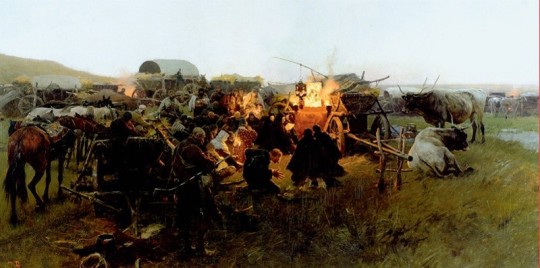
View On WordPress
0 notes
Photo

Józef Brandt (Polish, 1841-1915):
Alarm / Battle in a Barn (depicting scene from the January Uprising), oil on canvas, c.1880, via MNW.
52 notes
·
View notes
